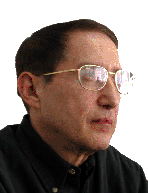

 |
Richard B. Gomez | Department of Computational and Data Sciences, GMU Intel co-founder Gordon Moore predicted in 1965 that the number of electronic components on a computer chip would double every year or two. “Moore’s Law” has been remarkably accurate even to this day, where the latest silicon processors now host some one hundred twenty five million transistors. This exponential growth in chip density has been the motivation behind the move towards computer nanotechnology and the quantum computer. Since adding more transistors to the chip by simply expanding the size of chips bogs down the computer speed because of the time it takes for electronic signals to traverse the chip, the only way to sustain this growth in computer power is to make transistors ever smaller. Of course, this also generates more heat that needs to be removed creating more computer problems. By the year 2020, Moore’s Law predicts that a one-square-centimeter chip will have over one billion transistors, with each transistor approaching the size of a large molecule. At this point, a fundamental change in the way we compute will have to be made because once we’ve entered the regime of individual molecules, atoms, and electrons, the laws of quantum mechanics reign. In the early 1980s, Paul Benioff Argonne National Laboratory) and Richard Feynman (California Institute of Technology) realized that soon the industry will be making logic gates so small that they will be made out of only a handful of atoms.. Once the atomic threshold is hit, the rules of conventional physics are replaced by that of quantum physics. In 1985, David Deutsch (Oxford University) used the quantum phenomenon of “superposition” to produce massively parallel computing – computing with multiple inputs at once in a single device. Deutsch proposed the quantum computer to get around the impending limit of Moore’s Law by taking advantage of different physical principles underlying atomic sized computer components. Thus, many now consider quantum computers to be an intriguing possibility to circumvent the atomic limits to Moore’s Law. In this talk we will look at the fascinating development of “Quantum Computing”. In particular, I will address the question: What are the prospects and progress of quantum computing? We will see that there is more to quantum computing than just cramming more atomic level logic gates. Quantum technology opens a whole new world of computing. If successful and I believe it will be, this computing technology will provide tremendous computing power based on quantum principles. |